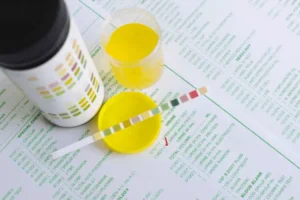
Most of the 50 percent of Americans who do drink consume low to moderate, amounts of alcohol (less than 1 per day). "States’ decisions about whether to expand their Medicaid programs have had stark implications for their uninsured rates," the authors wrote in their report. In 2017, five of the 17 states that had not expanded access to Medicaid through the Affordable Care Act had the highest rates of uninsured adults. Alcohol-related deaths in North Dakota are among the most likely to be due to chronic causes. Whilst the World Health Organization (WHO) and most national guidelines typically quantify one unit of alcohol as equal to 10 grams of pure alcohol, the metric used as a 'standard measure' can vary across countries. At the end of this topic page, we provide a number of potential sources of support and guidance for those concerned about uncontrolled drinking or alcohol dependency.

Fact-checking Biden and Trump's claims at the first debate
" Alprazolam was mentioned in 26% of the overdose deaths involving hydrocodone, 22% of the deaths involving methadone, and 25% of the deaths involving oxycodone. " For males, the rate increased from 2.1 in 2009 to 6.4 in 2018. For females, the rate increased from 0.7 in 2009 to 2.6 in 2018. For each year, rates were 2.4 to 3.0 times higher for males than females." "• The age-adjusted death rate for the White population (834.7) was 1.8 times greater than for the Asian non-Hispanic population (subsequently, Asian) (457.7) and 1.2 times greater than for the Hispanic population (723.6).
- Using data from the Medical Expenditure Panel Survey, Gaskin and Richard (2012) found that in 2010, 70.3 million adults had joint pain (53.4 million had “arthritis” pain), and 22.6 million reported that this pain was severe.
- This pattern of drinking is often termed 'binging,' where individuals consume large amounts of alcohol within a single session versus small quantities more frequently.
- For example, whereas the odds of reporting any pain increased by 17 percent among those with a college degree, they increased by 40 percent among those who never attended college.
- And nearly 80% of people over age 11 reported having drunk at some point in their lives.
- The third wave began in the early 2010s with the infiltration of fentanyl into the U.S. drug supply.
- Public health policies that address SUDs have often been underutilized in favor of criminal justice policies—e.g., the “War on Drugs”—that emphasize arrests, incarceration, and punishment.
Alcoholic liver disease was the most frequent underlying cause for alcohol-induced deaths.
Public health policies treat substance use as a health problem, while criminal justice policies treat it as a moral failure. The criminal justice approach has been misguided and largely ineffective (Neill, 2014). In contrast with a punitive zero-tolerance, War on Drugs approach, a public health or social determinants approach emphasizes integrating clinical care with efforts to improve structural environments and targeting both supply and demand factors at multiple levels (Dasgupta, Beletsky, and Ciccarone, 2018; Scutchfield and Keck, 2017). Susceptibility to substance abuse is influenced by individual/proximal factors (e.g., SES, psychological factors); community meso-level structures (e.g., family, peers, social environment); and macro-level structures (e.g., economic inequality, policies, corporate practices) (see Figure 6-1 in Chapter 6).
- Differences in mortality due to drug poisoning and alcohol-induced causes between metro and nonmetro areas followed similar trends, even as regional trends differed.
- We see that the proportion of deaths attributed to alcohol consumption is lower in North Africa and the Middle East and much higher in Eastern Europe.
- “Negative affect” (so sad nothing cheers you up, nervous, restlessness, hopeless, everything was an effort, worthless) showed smaller differences by SES.
- ††† Fully alcohol-attributable conditions include the 100% alcohol-attributable chronic causes as well as the 100% alcohol-attributable acute causes (i.e., alcohol poisonings that are a subset of deaths in the alcohol-related poisonings category and suicide by exposure to alcohol that are a subset of deaths in the suicide category).
Debate background: Election integrity remains key issue – even without evidence of widespread voter fraud
In the US, Canada, Australia, New Zealand, Argentina, and many European countries, alcohol is responsible for around a third of all traffic deaths. Alcohol use disorder, which includes alcohol dependence, is defined in the WHO's International Classification of Diseases (available here). Data on the prevalence of binge drinking by age https://ecosoberhouse.com/article/15-benefits-of-the-alcohol-free-lifestyle/ and gender in the UK can be found here, and trends in heavy and binge drinking in the USA can be found here. The map shows heavy drinkers – those who had an episode of heavy drinking in the previous 30 days – as a share of total drinkers (i.e., those who have drunk less than one alcoholic drink in the last 12 months are excluded).

New Mexico has the third-highest number of alcohol-related deaths per capita among all the states; it’s 23.4% higher than Alaska’s per capita death rate, which is the nation’s second-highest. Nevada’s alcohol-related death rate per capita is high, but it has a very low rate of underage deaths. Massachusetts has one of the nation’s lowest rates of under-21 alcohol-related drinking deaths. Florida has an elevated alcohol-related death rate but one of the lowest rates of under-21 deaths.
25 June 2024 — A new report from the World Health Organization (WHO) highlights that 2.6 million deaths per year were attributable to alcohol consumption, accounting for 4.7% of all deaths, and 0.6 million deaths to psychoactive drug use. Notably, 2 million of alcohol and 0.4 million of drug-attributable deaths were among men. "The comparison of deaths attributed to drug use among men and women over the past decade shows that the number of deaths alcoohol is better than drugs attributed to drug use disorders, in particular opioid use disorders, has increased disproportionately among women, with a 92 per cent increase in deaths attributed to opioid use disorders among women compared with a 63 per cent increase among men." " For each year, rates of alcohol-induced deaths for males aged 25 and over were higher than for females." " More than one-third of the overdose deaths involving cocaine also mentioned heroin (34%).
Immigrants Entering U.S. Under Biden
Historical perspective on alcohol consumption
- What’s more, Biden’s also significantly overstating how much insulin cost before the change.
- Since the charges were brought by the state of New York, Biden and the federal government are not party to the indictment and have no say in the charges, as USA TODAY previously reported.
- What's more, those rates rose by 450 percent from 2005 to 2017, according to the report.